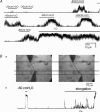Two-pore-domain potassium channels in smooth muscles: new components of myogenic regulation
- PMID: 16239268
- PMCID: PMC1464292
- DOI: 10.1113/jphysiol.2005.098897
Two-pore-domain potassium channels in smooth muscles: new components of myogenic regulation
Abstract
Gastrointestinal (GI) smooth muscles are influenced by many levels of regulation, including those provided by enteric motor neurones, hormones and paracrine substances. The integrated contractile responses to these regulatory mechanisms depend heavily on the state of excitability of smooth muscle cells. Resting ionic conductances and myogenic responses to agonists and physical parameters, such as stretch, are important in establishing basal excitability. This review discusses the role of 2-pore-domain K+ channels in contributing to background conductances and in mediating responses of GI muscles to enteric inhibitory nerve stimulation and stretch. Murine GI muscles express TREK-1 channels and display a stretch-dependent K+ (SDK) conductance that is also activated by nitric oxide via a cGMP-dependent mechanism. Cloning and expression of mTREK-1 produced an SDK conductance that was activated by cGMP-dependent phosphorylation at serine-351. GI muscle cells also express TASK-1 and TASK-2 channels that are inhibited by lidocaine and external acidification. These conductances appear to provide significant background K+ permeability that contributes to the negative resting potentials of GI muscles.
Figures




Similar articles
-
A pH-sensitive potassium conductance (TASK) and its function in the murine gastrointestinal tract.J Physiol. 2005 May 15;565(Pt 1):243-59. doi: 10.1113/jphysiol.2005.084574. Epub 2005 Mar 17. J Physiol. 2005. PMID: 15774516 Free PMC article.
-
The stretch-dependent potassium channel TREK-1 and its function in murine myometrium.J Physiol. 2011 Mar 1;589(Pt 5):1221-33. doi: 10.1113/jphysiol.2010.203869. Epub 2011 Jan 10. J Physiol. 2011. PMID: 21224218 Free PMC article.
-
Block of inhibitory junction potentials and TREK-1 channels in murine colon by Ca2+ store-active drugs.J Physiol. 2008 Feb 15;586(4):1169-84. doi: 10.1113/jphysiol.2007.148718. Epub 2008 Jan 10. J Physiol. 2008. PMID: 18187470 Free PMC article.
-
Aging and gastrointestinal smooth muscle.Mech Ageing Dev. 2004 Dec;125(12):907-10. doi: 10.1016/j.mad.2004.05.010. Mech Ageing Dev. 2004. PMID: 15563937 Review.
-
Muscarinic cationic current in gastrointestinal smooth muscles: signal transduction and role in contraction.Auton Autacoid Pharmacol. 2006 Jul;26(3):203-17. doi: 10.1111/j.1474-8673.2006.00366.x. Auton Autacoid Pharmacol. 2006. PMID: 16879487 Review.
Cited by
-
Vascular mechanotransduction.Physiol Rev. 2023 Apr 1;103(2):1247-1421. doi: 10.1152/physrev.00053.2021. Epub 2023 Jan 5. Physiol Rev. 2023. PMID: 36603156 Free PMC article. Review.
-
Role of potassium ion channels in detrusor smooth muscle function and dysfunction.Nat Rev Urol. 2011 Dec 13;9(1):30-40. doi: 10.1038/nrurol.2011.194. Nat Rev Urol. 2011. PMID: 22158596 Free PMC article. Review.
-
Response of the human detrusor to stretch is regulated by TREK-1, a two-pore-domain (K2P) mechano-gated potassium channel.J Physiol. 2014 Jul 15;592(14):3013-30. doi: 10.1113/jphysiol.2014.271718. Epub 2014 May 6. J Physiol. 2014. PMID: 24801307 Free PMC article.
-
A mechano- and heat-gated two-pore domain K+ channel controls excitability in adult zebrafish skeletal muscle.Proc Natl Acad Sci U S A. 2023 Nov 7;120(45):e2305959120. doi: 10.1073/pnas.2305959120. Epub 2023 Oct 30. Proc Natl Acad Sci U S A. 2023. PMID: 37903280 Free PMC article.
-
Expression of transient receptor potential channels and two-pore potassium channels in subtypes of vagal afferent neurons in rat.Am J Physiol Gastrointest Liver Physiol. 2010 Feb;298(2):G212-21. doi: 10.1152/ajpgi.00396.2009. Epub 2009 Dec 3. Am J Physiol Gastrointest Liver Physiol. 2010. PMID: 19959819 Free PMC article.
References
-
- Backx PH, Marban E. Background potassium current active during the plateau of the action potential in guinea pig ventricular myocytes. Circ Res. 1993;72:890–900. - PubMed
-
- Bai X, Bugg GJ, Greenwood SL, Glazier JD, Sibley CP, Baker PN, Taggart MJ, Fyfe GK. Expression of TASK and TREK, two-pore domain K+ channels, in human myometrium. Reproduction. 2005;129:525–530. - PubMed
-
- Bang H, Kim Y, Kim D. TREK-2, a new member of the mechanosensitive tandem-pore K+ channel family. J Biol Chem. 2000;275:17412–17419. - PubMed
-
- Buckingham SD, Kidd JF, Law RJ, Franks CJ, Sattelle DB. Structure and function of two-pore-domain K+ channels: contributions from genetic model organisms. Trends Pharmacol Sci. 2005;26:361–367. - PubMed
Publication types
MeSH terms
Substances
LinkOut - more resources
Full Text Sources

